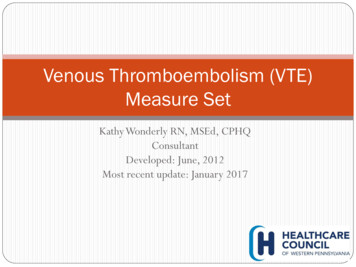
Transcription
Counseling Patients about FamilyPlanning and Contraception
More resources available at theDC Center for Rational Prescribingdchealth.dc.gov/dcrx
COURSE FACULTY Adriane Fugh-Berman, MD Mark Hathaway, MD, MPH Jamila Perritt, MD, MPH Susan Wood, PhD
CONFLICTS OF INTEREST Dr. Adriane Fugh-Berman is a paid expert witness at the request of plaintiffs in litigationregarding pharmaceutical marketing practices. Dr. Mark Hathaway is a paid trainer for Nexplanon birth control implant on behalf of Merck andis a paid member of the Clinical Advisory Boards for Afaxys and ContraMed.
COURSE OBJECTIVES1.Describe patient-centered care in the context of family planning.2.Assess who should be counseled for family planning services.3.Address potential provider barriers and biases for quality family planning.4.Discuss short acting and long acting contraception options.
UNINTENDED PREGNANCYPregnancies in the US by Intention45% of pregnancies in the US wereunintended (mistimed or unwanted)in 2011Kost 2015
UNINTENDED PREGNANCY IN DC44,910women in DC needed publicly supportedcontraceptive services and supplies in 2014.9,100 unintended pregnancies in 2014 were averted through62% of pregnancies wereconsidered unintended inDC in 2010.publicly funded family planning services, which would haveresulted in 4,400 unplanned births and 3,300 abortions.Guttmacher 2017
UNINTENDED PREGNANCY Births resulting from unintended or closely spaced pregnancies may beassociated with adverse maternal and child health outcomes and negativephysical and mental health effects for children. Planning, delaying, and spacing births may help women achieve theireducation and career goals.Sonfield 2013
PATIENT-CENTERED CARE“Providing care that is respectful of andresponsive to individual patient preferences,needs, and values and ensuring that patientvalues guide all clinical decisions.”—Institute of Medicine
PATIENT-CENTERED CONVERSATIONSThe provider contributesexpertise on characteristicsand effective use of methods.The patient contributesexpertise on their life, needs,and preferences.
ROLE OF THE PROVIDER Guide, not direct, the conversation Respectfully correct misperceptions “The options we’ve discussed fit your preferences. What doyou think about these?” Example: “All of these options are non-hormonal anddon’t cause changes to your period. What do you thinkabout these?”
Clinical pathway of family planning services for women and men of reproductive agePROVIDING QUALITYFAMILY PLANNINGSERVICESRecommendationsfrom the CDC andthe US Office ofPopulation Affairs
PRINCIPLES OF QUALITY COUNSELINGEstablish s needsMake a plantogetherAdapted from ProvidingQuality Family PlanningServices: Appendix CCDC 2014
WHO SHOULD BE COUNSELED All patients of reproductive age (regardless of gender)should be screened for pregnancy intention. The ultimate goal is to determine, respect, and meet theneeds of each patient. Offer a full range of FDA-approved or FDA-cleared*contraceptive methods.*Some contraceptive devices are “cleared” instead of“approved” by the FDA because they are substantiallyequivalent to an existing device.
ONE KEY QUESTIONIf yes“Would you like tobecome pregnantin the next year?”If noBeginpreconceptioncounselingBegin discussion onavailable contraceptivemethods and safe sexpracticesOne Key Question powertodecide.org
Addressing ambivalence“How would you feel ifyou got pregnant in thenext year?”
PRECONCEPTION COUNSELINGPatients who are seeking pregnancy,are at risk for unintended pregnancy,or are ambivalent about pregnancyintention should be offeredpreconception health services
PATIENT-CENTERED CARE FOR FAMILY PLANNING Treat each person as a unique individual Provide accurate, easy-to-understand informationbased on the patient’s needs and goals Ask questions, listen thoughtfully (don’t interrupt),and respond appropriately Offer the support that the individual patient wants asthey select contraception that matches theirpreferences and needs
PROVIDER BIASES FOR SPECIFIC METHODS Some providers may emphasize—or avoid—discussingcertain methods. Ask yourself: Are there methods you would hesitate to discuss? Are there methods you discuss more than others? Why? What do you do if you think the client is making the“wrong” choice?Recognize that everyone has assumptions and biases. Beingaware of them is the best way to avoid imposing beliefs onpatients.
“WHAT IS IMPORTANT TO YOU ABOUT YOUR BIRTHCONTROL METHOD?”Sample answers:
POTENTIAL BARRIERS FOR PROVIDERS Scheduling enough time to provide counseling Inadequate training Stocking methods Misconceptions about methods
CDC CONTRACEPTION APP An easy-to-use reference thatprovides information on bestcontraceptive choices in patientswith specific medical conditions Available for iOS in the Apple Storeor Android in the Google Play Store
REFERRALS
SPECIAL CONCERNS FOR ADOLESCENTS Provide comprehensive information about how toprevent pregnancy and STIs. Reassure them that family planning services areconfidential. Refer pregnant/parenting adolescents to supportprograms and resources. Encourage adolescents to discuss sexual andreproductive health with their parents, guardians, orother trusted adults. Display materials that include young people.
COUNSELING METHODSPresent information about available contraceptive methods in a waythat prioritizes patient preferencesExamples of Ways to Categorize Methods Tiered Approach Offering methods in order of effectivenessBarrier vs. non-barrier methodsHormonal vs. non-hormonal methodsLong-acting vs. short-acting
MALE STERILIZATION (VASECTOMY) Surgical procedure (outpatient)More than 99% effectivePermanentRisks Transient pain or bleeding Infection, other surgical complications
FEMALE STERILIZATION (TUBAL LIGATION) Surgical procedureMore than 99% effectivePermanentRisks Transient pain or bleeding Infection, other surgical complications
TYPES OF LONG-ACTING REVERSIBLE CONTRACEPTION (LARCS)GenericBrandReservoirT380A Copper IUDParaGard380 mm2Etonogestrel implantNexplanon68 mg ENGLNG IUD 20 mcg/24 hrMirena52 mg LNGLNG IUD 14 mcg/24hrSkyla13.5 mg LNGLNG IUD 18.6 mcg/24hrLiletta52 mg LNGLNG IUD 17.5 mcg/24hrKyleena19.5 mg LNGENG etonogestrel; LNG levonorgestrel
HORMONAL IMPLANT Inserted in the upper arm by a healthcare provider More than 99% effective Lasts up to 3 years Risks Menstrual changes Weight gain Acne Mood swings or depressed mood Headache
COUNSELING ABOUT LARCS Insurance coverage is important to discusswith patients Device and insertion Follow-up visits Removal Remind patients that LARCs can beremoved at any time Create a system within your practice sopatients can get same-day LARCs ifdesired
5 TYPES OF INTRAUTERINE DEVICES (IUDS)SkylaParaGardKyleena(copper)MirenaLiletta
COPPER IUD Inserted by a healthcare provider Duration of effectiveness Copper IUD: up to 10 years (up to 12years) Possible side effects: Cramps, longer/heavier menses, spottingbetween periods, allergic reaction Risk of pregnancy More than 99% effective
HORMONAL IUDS Inserted by a healthcare provider Duration of effectiveness Hormonal IUD: 3-5 years (dependingon type) Possible side effects: Irregular bleeding, amenorrhea,abdominal/pelvic pain Risk of pregnancy More than 99% effective
BIRTH CONTROL METHODSFamily Planning National Training Center: ods-options-chart
INJECTABLE Depot injection of progestin into the arm or hip every threemonths Subsequent injections can be administered as earlyas 10 weeks and as late as 15 weeks after thepreceding injection Effectiveness More than 99% effective when injections taken ontime every three months Efficacy declines as time between shots increases
INJECTABLE Potential risks and adverse events Bone density loss Irregular bleeding, spotting, or no periods Headaches Weight gain Nervousness It may take up to 10 months after stopping shotsto become pregnant.
ORAL CONTRACEPTION (“THE PILL”) Combined estrogen/progestin pills A pill must be taken every day near the same time Progestin-only pills (“Minipill”) Used during breastfeeding or in women at high risk of bloodclots, rarely used otherwise Possible side effects Irregular bleeding, spotting, lighter or absent periods Headaches Breast tenderness Effectiveness 99% effective with perfect use (one pill per day, within a fewhours of the same time) Combination pills are 91% effective with imperfect use All pills are more effective when taken within a few hours of thesame time every day. Particularly important for minipill effectiveness
MONOPHASIC VS. BI- AND TRIPHASIC PILLS Monophasic pills: estrogen and progestin levels stayconsistent throughout the three weeks of active pills Can be associated with fewer side effects due to asteady hormone dose Biphasic and triphasic pills: differing levels of estrogenand/or progestin throughout the three weeks of active pills.May be associated with heavier bleeding and other sideeffects. Equally effective for pregnancy prevention Deliver less total amount of hormone in the body
THE PILL AND RISK OF CANCERS The risk of breast and cervical cancers increases inwomen who use oral contraceptives. The risk of endometrial, ovarian, and colorectalcancers is decreases in women who use oralcontraceptives. Most evidence about the link between oralcontraceptives and cancer risk comes fromobservational studies. Data from observational studies cannot establishthat an exposure causes or prevents a disease.NCI 2018
GENERIC ORAL CONTRACEPTIVE OPTIONS60 different generic combination pills are available on the market.Each active pill contains: An estrogen component: Ethinyl estradiol Mestranol A progestin component: Levonorgestrel Desogestrel Norethindrone Norgestrel DrospirenoneProduct names include: Demulen, Genora, Loestrin, Microgestin, Necon, Estrostep,Ovcon, Ortho-NovumYour patients may need to try different formulations to find the right generic for them.
HORMONAL PATCH Placed on the skin each week 99% effective when patches replacedon time 91% effective with imperfect use (patches notreplaced on time, patches not replaced whenmisplaced) Risks Irregular bleeding, spotting, or lighter periods Headaches Breast tenderness Skin irritation at the site of the patch
HORMONAL VAGINAL RING Ring placed in the vagina every month Risks Irregular bleeding, spotting, or lighter periods Vaginal discharge Headaches Breast tenderness Mood changes 99% effective when ring replaced each month on time 91% effective with imperfect use (ring left out of vaginafor more than two days, ring replaced irregularly)
WITHDRAWAL METHOD “Pull-out method” The penis is pulled out of the vagina before ejaculation Can be difficult to do perfectly 96% effective with perfect use 78% effective with imperfect use No hormones, no side effects, nothing to buy Does not protect against STIs
FERTILITY AWARENESS METHODS (FAMS) “Natural family planning” or “rhythm method” Requires monitoring of fertility signs Temperature method Cervical mucus method Calendar method Abstain from intercourse or use a condom or otherbarrier method on fertile days 76-88% effective depending on method and diligence
SPERMICIDESPERMICIDAL SPONGE Must be used for every act of vaginal intercourse Put in the vagina before sex Risks Irritation Allergic reaction Possible side effects: Irritation 91% effective with perfect use for nulliparas 88% effective with imperfect use 80% effective with perfect use for people who havegiven birth 76% with imperfect use Provides some protection against STIs No prescription necessary 82% effective with correct use 71% effective with typical useNo prescription necessary
DIAPHRAGM OR CERVICAL CAP WITH SPERMICIDE Must be used with spermicide; placed in the vagina immediatelybefore or several hours before sex. Must be left in place six hours after sex, should be removed before24 hours. Risks Irritation Allergic reactions Diaphragm and spermicide: 94% effective with perfect use 88% effective with imperfect use Cervical cap and spermicide: 86% effective for nulliparous people;71% effective for people who have given birth Provides some protection against STIs Prescription and fitting necessary for most diaphragms Fit-free diaphragms now available
EXTERNAL (MALE) CONDOM Must be used for every act of intercourse 98% effective with perfect use 85% effective with imperfect use Risks Irritation Allergic reaction to latex Best protection against STIs No prescription necessary
INTERNAL (FEMALE) CONDOM Put inside vagina or anus Must be used for every act of intercourse Risks Irritation Allergic reaction to latex 95% effective with perfect use 79% effective with imperfect use Best protection against STIs No prescription necessary
EXTENDED-CYCLE BIRTH CONTROL Branded versions of extended-cycle birthcontrol pill exist. However, any birth control pill can be used asan extended-cycle pill. Patients can skip placebo pills and start thenext pack of active pills.
QUICK START (SAME-DAY CONTRACEPTION) Women with a negative urine pregnancy test can begin using the birth control pill,patch, or vaginal ring immediately after an office visit, at any point in the menstrualcycle. Pelvic exams, Pap smears, and STI screenings are not required for starting orcontinuing hormonal contraception. Women who initiate oral contraceptives between periods have no more disruption inmenstrual patterns than those who wait until menses. Westhoff 2003 Starting a contraceptive method the same day as an office visit improves adherence. Quick start algorithm: ds/2014/12/QuickstartAlgorithm.pdf
Emergency contraception chart
EMERGENCY CONTRACEPTIONLevonorgestrel (LNG) Available as LNG 1.5 mg (1 pill) or LNG 0.75 mg (2 pills) Can be purchased behind-the-counter, without a prescriptionUSAGEPOSSIBLE SIDE EFFECTSShould be taken as soonas possible within 3 daysafter unprotected sex May be effective up to 5days after unprotectedsexLess effective the longerthe patient waits to takeit after unprotected sex HeadacheAbdominal painTirednessBreast painNausea or vomitingMenstrual changesDizzinessEFFECTIVENESSRisk of pregnancy: 7 outof every 8 women whowould have gottenpregnant will notbecome pregnant aftertaking levonorgestrel
EMERGENCY CONTRACEPTIONCopper IUD Effective for patients regardless of weightUSAGETIMELINEEFFECTIVENESSMust be placedwithin 120 hours (5days) afterunprotected sexWill protect againstpregnancyimmediately and upto 10 yearsMore than 99%effective
YUZPE METHOD – EMERGENCY CONTRACEPTION Patients can take birth control pills in twodoses, 12 hours apart as emergencycontraception. It only works with certain brands. Most effective within 72 hours afterunprotected sex. More ting-back-to-the-70s
EMERGENCY CONTRACEPTION Available forms: Copper IUD LNG 1.5 mg (1 pill) or LNG 0.75 mg (2 pills) Ulipristal acetate 30 mg (1 pill) Combined oral contraceptives at a higher dose than usual can be used asemergency contraception (Yuzpe regimen) All types of emergency contraception pills are significantly less effective for individualswith higher BMIs. Physicians should advise patients with BMIs higher than 25 to consider copper IUDs,as they have more than 99% efficacy as emergency contraception regardless of apatient’s BMI.
Case studies:Discussing family planning in theprimary care setting
What questionsdo you ask?
It is okay to ask a parent toleave the room in order to fosteradolescent patient autonomy.
Increased risk of PID with IUDs? Slight increase for 20 daysafter placement, then thesame as general population Patients with a history ofPID are eligible for IUDs. Active PID is acontraindication.Patient would like to becomepregnant at a later date. DoIUDs decrease future fertility? IUDs do not decrease futurefertility.
Is the patient currently sexuallyactive? What are the patient’sthoughts/feelings about birthcontrol? What risk factors may bepresent?
What questionsdo you ask?
Issues to consider: Address access to timely refill Office system Insurance Address individual logisticalproblems False positive for pregnancy test Potentially switching to a newmethod
What questionsdo you ask?
Ask the patient if she is currentlysexually active Inform the patient that ACEinhibitors can cause birthdefects Offer validation about what thepatient is already doing well Check back in if the patientchooses a method that containsestrogen
Insurance Coverage ofContraception andNew DC Pharmacists Law
COVERAGE OF CONTRACEPTION UNDER THE ACA All commercial health insurance plansmust cover contraceptive methodsand counseling. Plans must cover these serviceswithout charging a copayment whenprovided in-network.FDA-approved contraceptive methodsprescribed by a woman’s doctor arecovered, including Barrier methods Diaphragms, sponges, condoms Hormonal methods Birth control pills, vaginal rings LARCs Emergency contraception Sterilization Patient education and counseling
NEW DC LAW DC Act 22-246. Defending Access to Women’s Health CareServices Amendment Act of 2018. Allows pharmacists to prescribe and dispense certaincontraceptives Requires that insurers authorize self-administeredhormonal contraception (up to a 12-month supply)prescribed and dispensed by a pharmacist The act is expected to go into effect in January 2019.
BENEFITS OF A 1-YEAR SUPPLY OF CONTRACEPTION Women who received a 1-year supply of contraception comparedto women who received a 1- or 3- month supply were: 30% less likely to have a pregnancy More likely to adhere to the method Dispensing a 1-year supply was associated with a 46% reductionin the odds of having an abortion.Foster 2011
PHARMACIST-PRESCRIBED CONTRACEPTION Pharmacists will be required to complete a training about in orderto prescribe and dispense self-administered hormonalcontraceptives. Pharmacists will provide the patient with written material,developed by the Board and the Department of Health,describing all FDA-approved or FDA-cleared contraceptives,including LARCs. Patients will use a self-screening tool (developed by the Board ofMedicine) to identify risk factors.
REQUIREMENTS FOR PHARMACISTSThe pharmacist will provide appropriate counseling andinformation on the product furnished, including: Dosage Effectiveness Potential adverse effects Whether or not it protects against sexually transmittedinfections The importance of receiving recommended preventive healthscreenings Pharmacists will refer patients to a primary care provideror to a clinic.
OTHER REQUIREMENTS Pharmacies will be required to display in store and online a list ofcertified pharmacists’ available hours to prescribe and dispensecontraception. The Board of Pharmacy will be required to maintain a public list ofall pharmacists certified to prescribe and dispense contraception,including their locations.
DCRX COURSESDiabetesHIV PreventionOpioidsRational Prescribing forOlder AdultsMedical CannabisGeneric Drugsand many more great topics!
More resources available at theDC Center for Rational Prescribingdchealth.dc.gov/dcrx
CONFLICTS OF INTEREST Dr. Adriane Fugh-Berman is a paid expert witness at the request of plaintiffs in litigation regarding pharmaceutical marketing practices. Dr. Mark Hathaway is a paid trainer for Nexplanon birth control implant on behalf of Merck and is a paid member











